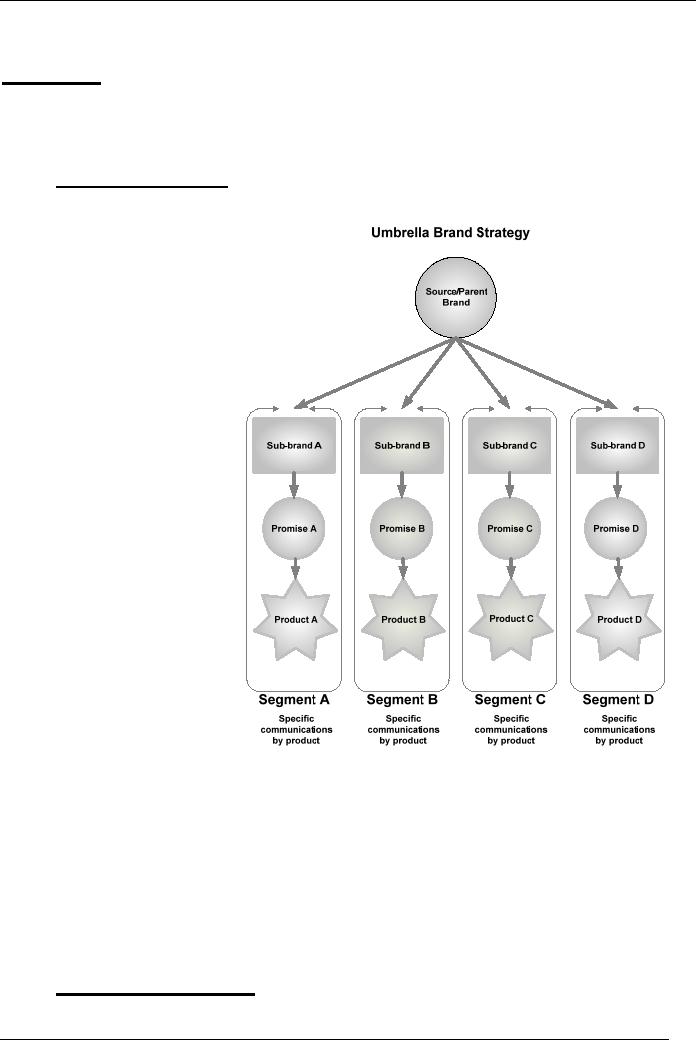 |

Brand
Management (MKT624)
VU
Lesson
28
BRAND
ARCHITECTURE
Introduction
Discussion
on brand architecture from
the standpoint of managing brands
continues from the
previous
lecture. We shall learn two
more strategies relating
brand-product relationship
before
we
summarize the concept as it applies to
brand management.
5.
Source
brand strategy
This
is very close to umbrella brand
strategy with one exception
every product has a
different
brand name
Figure
36
under
the source name.
This
is a two-tiered
structure
with double
branding1.
Most of the
Japanese
cars are
examples
of the source
brand
strategy.
One
product starts and
gets
sub-divided into
sub-species
giving
them
different names.
As
is already learnt,
different
names are
given
to different
products
to fulfill
different
promises.
Each
product with a
different
name carries
one
specific contract.
The
power of the
source
supports the
offspring
until they
become
established
brands
in their own
right.
The
sub-brands or the
offspring
become so strong owing
basically to strength of the source
that a point comes
when
the source takes the back
seat and offspring emerge as
the main brands because
of
their
own promise.
If
you look at the source brand
on Japanese cars, you may
not find that. The
brand
expression
is limited only to the logo
of the source, because the
offspring have
developed
a strong identity of their
own.
It
is a unique situation in which
the brand strategy offers a
two-level sense of
difference
and
depth2.
The family spirit dominates!
Toyota and Honda are
excellent examples of
this
strategy. And, there are
many more.
6.
Endorsing brand strategy
The
endorsing brand is generally
the company name, which
takes on the overtones of
a
brand
name. It covers groups of diverse
products in the shape of
product brands, line
109

Brand
Management (MKT624)
VU
brands
and range brands. Strong company names
support different brands
that
demonstrate
their originality - LU in the
category of biscuits on the
Pakistani market is
an
example of this strategy.
Cars by GM (General Motors)
are another example on
the
side
of consumer durables.
The
endorsing brand strategy is one of
the least expensive ways of
giving substance to a
company
name as a brand name. The company name in
return gives strength to
the
product
brand name.
What
strategy to choose?
The
six models discussed are
the typical cases of
branding policies adopted by
different
companies
as brand architecture. Different
strategies have different
advantages and
disadvantages
to offer. There is no prescribed list of
"dos" and "don'ts". In reality,
there is no
fixed
model for a certain
situation. Companies use one or a
combination of the
models
discussed.
It
is not a matter of style. It is
very strategic in nature aimed at
promoting company's
products
with
a long term view. The
nature of arrangements used by the
companies is developed in
response
to the strategic situations of those
companies, their markets, competition,
and
company
resources.
The
choice of brand architecture of a
company, therefore, is a reflection of
the strategy it
chooses
under a certain set of
circumstances. It must be considered in
the light of three
factors:
the
product; consumer behavior, the
firm's competitive
position.
Summary
Brand
architecture is creation and management
of different brands as an
arrangement
compatible
with the strategic situation
of a company. The strategic
situation demands a
certain
action
on part of the company as a
response to fulfilling the
market needs. Given
the
circumstances
of the moment, companies decide on
strategic issues of whether to go
for a
stand-alone
brand, an extension, or a combination of
both. As part of the
architecture, brands
then
are managed as a portfolio or a
set of portfolios.
What
is important is to formulate the
right strategy for managing
brands. There are six types
of
different
strategies companies generally employ
for this purpose. It is the
job of the business
managers
to determine which one suits
their purposes the
most.
Bibliography:
1.
Jean-Noel Kapferer: "Strategic Brand
Management Creating and Sustaining
Brand
Equity
Long Term"; Kogan Page
(200)
2.
Jean-Noel Kapferer: "Strategic Brand
Management Creating and Sustaining
Brand
Equity
Long Term"; Kogan Page
(200)
Suggested
readings:
1.
Jean-Noel Kapferer: "Strategic Brand
Management Creating and Sustaining
Brand
Equity
Long Term"; Kogan Page
(187-210)
110

Brand
Management (MKT624)
VU
CHANNELS
OF DISTRIBUTION
Introduction
Moving
on to channels of distribution, the
thrust is going to be on creating
channels that
optimize
availability of your brands to customers
with highest possible cost
efficiencies.
Depending
on the nature of brand
architecture, managers have to
decide on the channel
partners
that
offer a high level of
compatibility with the goal
of achieving operation and cost
benefits.
Why
Channels?
With
brand architecture in place, we
are now ready to optimally
develop the
brand-consumer
relationship
in terms of making the brand
available to him. Unless we
have means to ascertain
that
the brand is available at
the place of our target
market's choice, we cannot
ensure
marketing
success in any field of the
marketing area. To make our
brand available we
need
help
of different businesses that
form channels.
Not
one firm can master all the
channel functions and,
therefore different channel members
get
into
arrangements to help each other
achieve their respective goals. Channel
members are
distributors,
wholesalers, retailers who
form a vital chain of supply
for transfer of our
brand
from
one hand to another.
The
strategic question here is how
many hands do we need to ensure efficient
and cost effective
transfer
of our brand to the
consumer? There are quite a
few functions that are
performed
between
the point of production and
the point where the
brand finally gets into
the hands of the
ultimate
consumer.
The
final touch is given, in
many cases, by retailers,
especially when you are
dealing with
consumer
products. Why is it that some companies
choose the conventional
channels, while
others
seem to be a little adventurous by
putting up their own retail
stores, and yet a few
others
who
may prefer direct marketing
are a few questions that
need to be answered through
discussion
here!
With
the basic objective of
making our brand valuable
and powerful, we must consider a
few
strategic
options that lay the
foundation for the nature of
channels that leverage our
brand and
give
it power. Those considerations
could be the
following:
Strategic
Options
1.
The nature of the
product-market relationship
We
must firstly be clear about
the nature of our product -
whether it is a consumer
product,
a specialized product, or an industrial
product along with its
application.
Consumer
consumables will have a channel
more elaborate than durables.
Specialized
products
may have a different set-up
of specialized dealers or company's own
outlets.
Industrial
products may yet be sold in
another way or through a
combination of both.
Customer
relationship management (CRM) takes on an
added dimension if
company
sells
directly and applications are
technical requiring company's
guidance1.
2.
The make-up of the segment in
terms of volume
constituents
We
must be sensitive to how
much what category of
customers constitute toward
the
total
volume of business. That understanding
will shed light on the
channel make-up.
As
an example, if the market is
divided by 80-20 rule, that
is, 20% of customers
constitute
80% of business; we may have
two different channels of
distribution,
meaning
a combination. We may cover
the 80% market through
our own sales
force,
while
use dealers for the
remaining 20% of the market
that may be sparse.
111

Brand
Management (MKT624)
VU
3.
The level of growth of the
segment
If
the segment is growing fast, we
may like to follow the
conventional methods in
vogue;
if it is well established, old and
growing slowly, we may like
to think of
something
new and different to gain
power.
4.
The amount of power that
your brand and your company
enjoy in the market
place
An
important determinant, power
becomes the basis of
negotiations. The one who
has
more
power negotiates from a position of
strength, as a traditional rule in
all walks of
life.
If you are a new brand and a
new company, you may
like to resort to the
strength
of
regionally strong distributors;
conversely, if your brand is
strong it may attract
those
distributors
to you thus adding to your
power.
It
is, however, difficult for
one party to monopolize power
within the
distribution
channels
system or the supply chain.
It boils down to the
positive part played by
each
member
of the channel that enhances
overall power of all and hence lead to
profitability
for
all. This highlights the
fact that it basically is a
partnership in which all
have to play
positive
regardless of the amount of
power he handles.
Three
strategic areas channels
impact
Having
considered the factors that
should lay the foundation
for the right channels; we
must
also
be concerned about the
strategic areas that are
impacted by our choice of
channels2.
The
choice
of channels therefore becomes
very strategic in
itself.
1.
Customer value
The
nature of channels either
enhances or reduces customer
value based on
service
quality
and the efficiency with
which the channels make
products available. Customer
value
means real performance, delivering
what was promised so that
the customer
gets
the right combination of product quality,
fair price, and good
service.
If
the quality of service is
poor and customers cannot
enjoy that product's
benefits due
to
non-availability, customers will switch
to a competitive brand. High
quality of
product
is not a guarantee of high customer
value if the product is
delivered
inefficiently.
Anything that is promised to be
delivered direct and fast will lose
its very
purpose
if it is not delivered the
way it is promised.
2.
Sales revenues
With
the prime objective of
developing an effective distribution
outreach, marketing
channels
determine the number of
existing and potential customers.
The total number of
customers
is the basis of revenue.
This relates the reality
that customers want to buy
at
locations
of their choice. If a company
cannot identify the
potential locations
(meaning
if
the company is lacking on one
account of customer value), it is
bound to lose its
customers
and hence potential revenues.
3.
Profitability
The
structure of marketing channels
has a direct bearing on
margins and profitability.
Effective
outreach has a cost. The
cost is paid for logistics, warehousing,
inventory
management
and as margins to all members of the
channel. How much does it
affect
profitability
is an important question!
Keeping
in view the impact of all
the three factors, coupled
with historical
background,
a
company decides on what
channels it should choose and
how it will manage those to
attain
its goals.
112

Brand
Management (MKT624)
VU
Two
companies dealing in the same
product can have different
marketing channels
designed
to reach the same customers in
the same market. A graphic
illustration in the
next
lecture explains this
phenomenon.
Summary
Strategic
considerations must be taken in
their proper perspective to
decide the right
channels
for
our business. We must carefully
study the product-market
relationship, the level of
business
enjoyed
by different segments and their size as
constituents of the overall
market, the growth of
segments,
and the amount of power
enjoyed by different members.
With
that in mind, we should move
on to the next step that
lets us study the impact of
the
under-study
nature of channels on the
areas of customer value,
sales revenue, and
profitability.
Bibliography:
1.
Roger J. Best: "Market-Based Management
Strategies for Growing Customer
Value
and
Profitability"; Prentice Hall
(273)
2.
Roger J. Best: "Market-Based Management
Strategies for Growing Customer
Value
and
Profitability"; Prentice Hall
(272)
113
Table of Contents:
- UNDERSTANDING BRANDS – INTRODUCTION:Functions of Brand Management, Sales forecast, Brand plan
- INTRODUCTION:Brand Value and Power, Generate Profits and Build Brand Equity
- BRAND MANIFESTATIONS/ FUNDAMENTALS:Brand identity, Communication, Differentiation
- BRAND MANIFESTATIONS/ FUNDAMENTALS:Layers/levels of brands, Commitment of top management
- BRAND CHALLENGES:Consumer Revolt, Media Cost and Fragmentation, Vision
- STRATEGIC BRAND MANAGEMENT:Setting Objectives, Crafting a Strategy, The Brand Mission
- BRAND VISION:Consensus among management, Vision Statement of a Fast Food Company, Glossary of terms
- BUILDING BRAND VISION:Seek senior management’s input, Determine the financial contribution gap
- BUILDING BRAND VISION:Collect industry data and create a brand vision starter, BRAND PICTURE,
- BRAND PICTURE:Brand Value Pyramid, Importance of being at pinnacle, From pinnacle to bottom
- BRAND PERSONA:Need-based segmentation research, Personality traits through research
- BRAND CONTRACT:The need to stay contemporary, Summary
- BRAND CONTRACT:How to create a brand contract?, Brand contract principles, Understand customers’ perspective
- BRAND CONTRACT:Translate into standards, Fulfill Good Promises, Uncover Bad Promises
- BRAND BASED CUSTOMER MODEL:Identify your competitors, Compare your brand with competition
- BRAND BASED CUSTOMER MODEL:POSITIONING, Product era, Image Era, An important factor
- POSITIONING:Strong Positioning, Understanding of components through an example
- POSITIONING:Clarity about target market, Clarity about point of difference
- POSITIONING – GUIDING PRINCIPLES:Uniqueness, Credibility, Fit
- POSITIONING – GUIDING PRINCIPLES:Communicating the actual positioning, Evaluation criteria, Coining the message
- BRAND EXTENSION:Leveraging, Leveraging, Line Extension in detail, Positive side of line extension
- LINE EXTENSION:Reaction to negative side of extensions, Immediate actions for better managing line extensions
- BRAND EXTENSION/ DIVERSIFICATION:Why extend/diversify the brand,
- POSITIONING – THE BASE OF EXTENSION:Extending your target market, Consistency with brand vision
- DEVELOPING THE MODEL OF BRAND EXTENSION:Limitations, Multi-brand portfolio, The question of portfolio size
- BRAND PORTFOLIO:Segment variance, Constraints, Developing the model – multi-brand portfolio
- BRAND ARCHITECTURE:Branding strategies, Drawbacks of the product brand strategy, The umbrella brand strategy
- BRAND ARCHITECTURE:Source brand strategy, Endorsing brand strategy, What strategy to choose?
- CHANNELS OF DISTRIBUTION:Components of channel performance, Value thru product benefits
- CREATING VALUE:Value thru cost-efficiency, Members’ relationship with brand, Power defined
- CO BRANDING:Bundling, Forms of communications, Advertising and Promotions
- CUSTOMER RESPONSE HIERARCHY:Brand-based strategy, Methods of appropriations
- ADVERTISING:Developing advertising, Major responsibilities
- ADVERTISING:Message Frequency and Customer Awareness, Message Reinforcement
- SALES PROMOTIONS:Involvement of sales staff, Effects of promotions, Duration should be short
- OTHER COMMUNICATION TOOLS:Public relations, Event marketing, Foundations of one-to-one relationship
- PRICING:Strong umbrella lets you charge premium, Factors that drive loyalty
- PRICING:Market-based pricing, Cost-based pricing
- RETURN ON BRAND INVESTMENT – ROBI:Brand dynamics, On the relevance dimension
- BRAND DYNAMICS:On the dimension of knowledge, The importance of measures
- BRAND – BASED ORGANIZATION:Benefits, Not just marketing but whole culture, Tools to effective communication
- SERVICE BRANDS:The difference, Hard side of service selling, Solutions
- BRAND PLANNING:Corporate strategy and brands, Brand chartering, Brand planning process
- BRAND PLANNING PROCESS:Driver for change (continued), Brand analysis
- BRAND PLAN:Objectives, Need, Source of volume, Media strategy, Management strategy